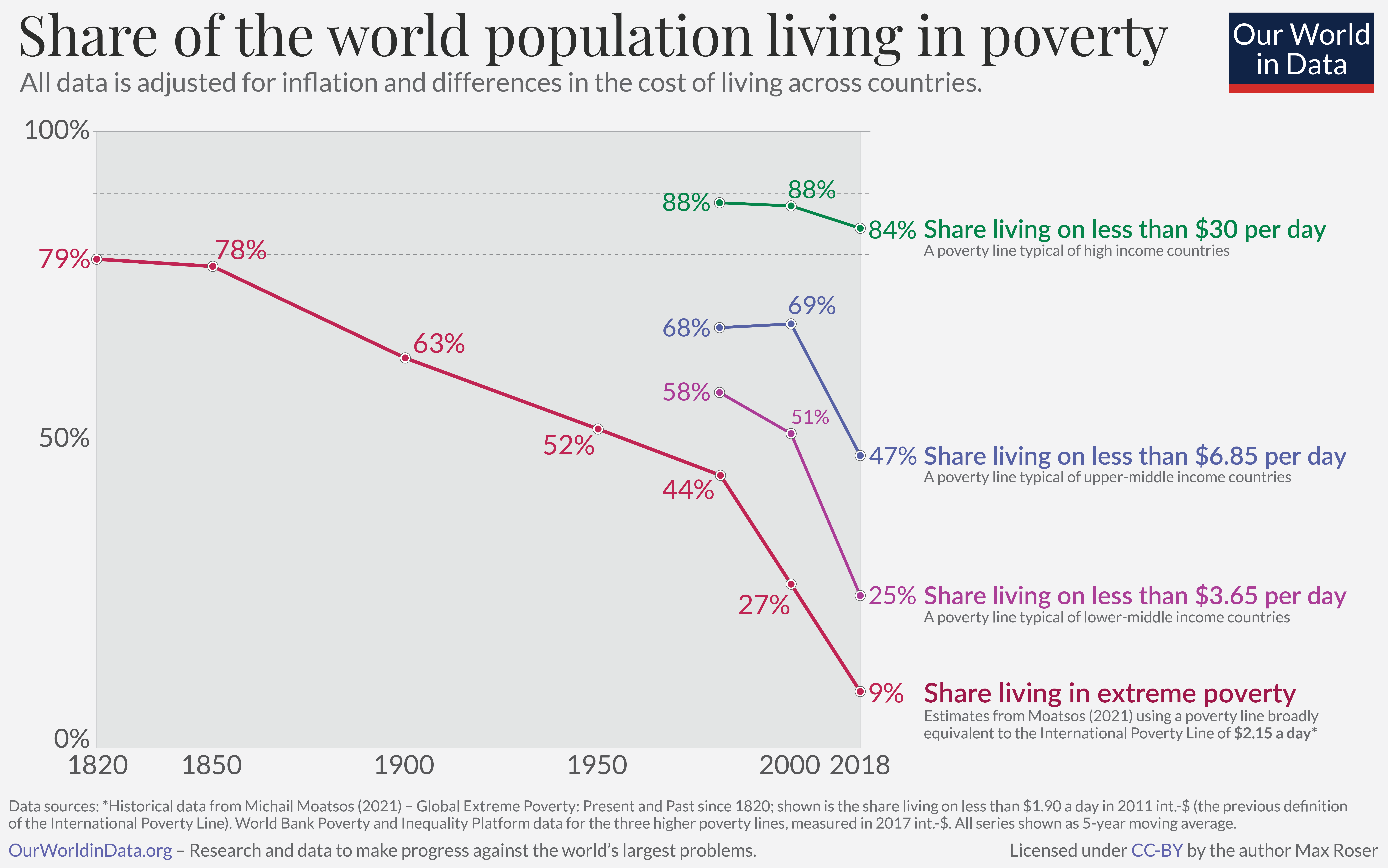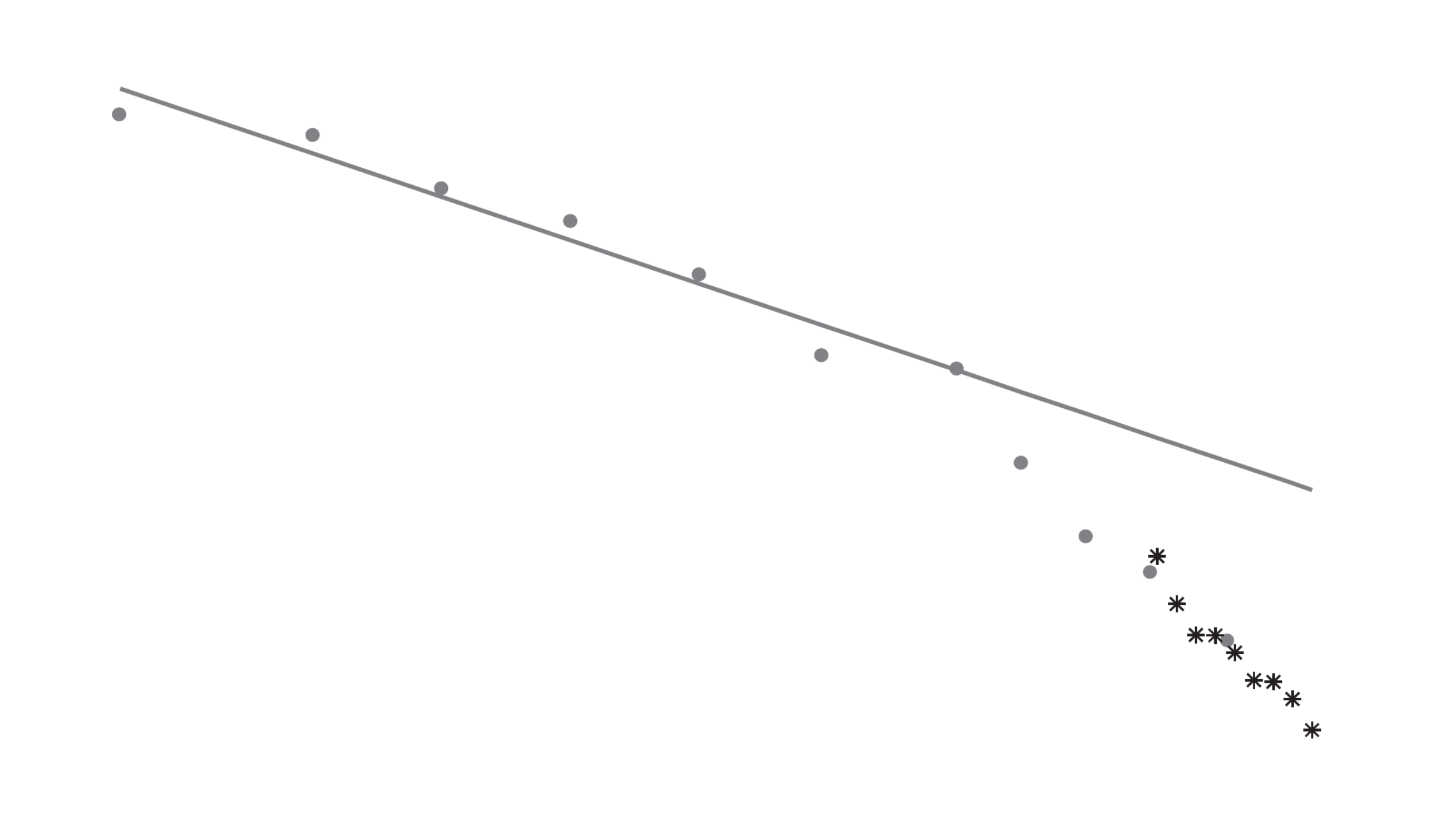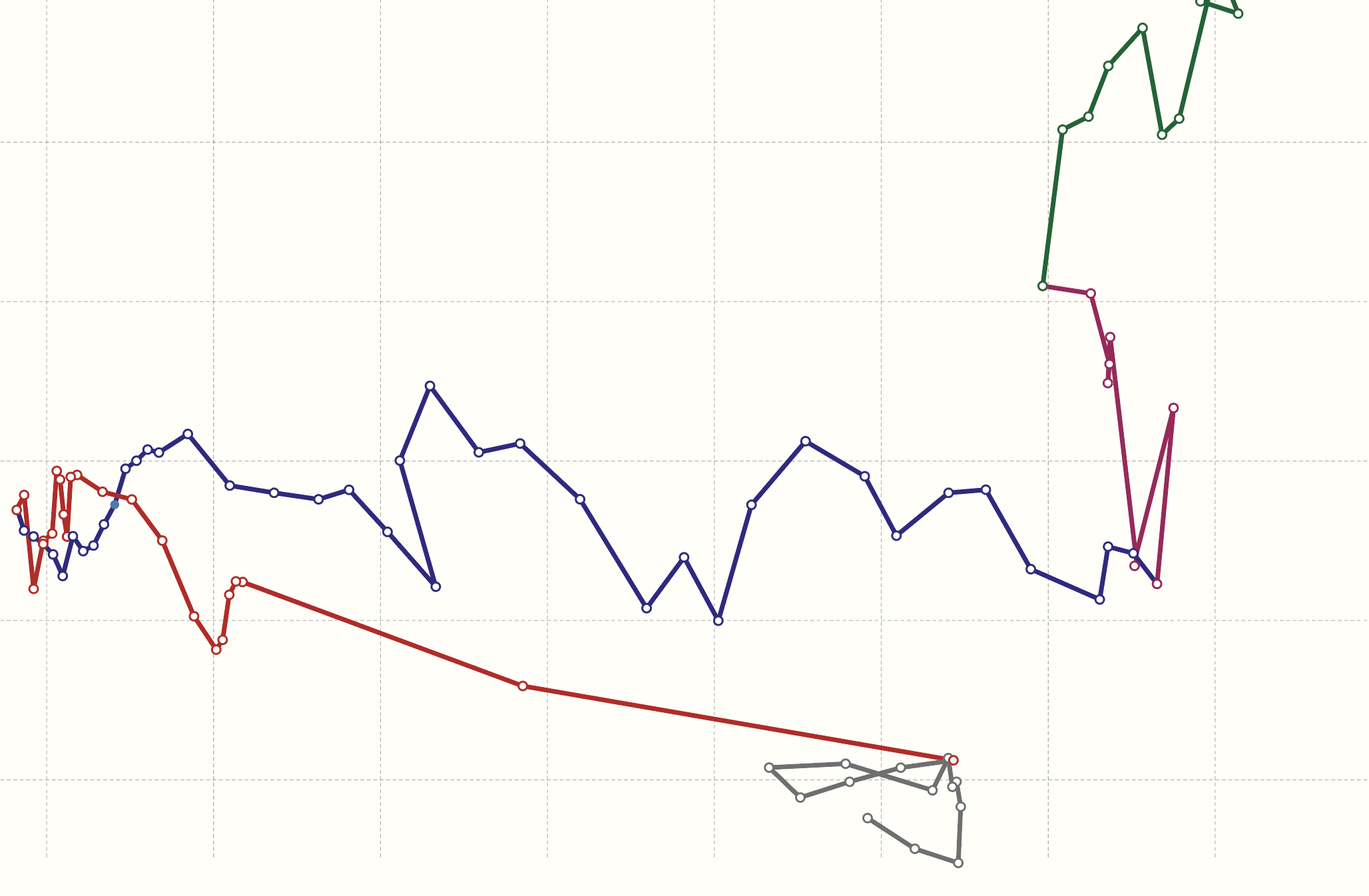Poverty
Global poverty is one of the most pressing problems that the world faces today. The poorest in the world are often undernourished, without access to basic services such as electricity and safe drinking water; they have less access to education, and suffer from much poorer health.
In order to make progress against such poverty in the future, we need to understand poverty around the world today and how it has changed.
On this page you can find all our data, visualizations and writing relating to poverty. This work aims to help you understand the scale of the problem today; where progress has been achieved and where it has not; what can be done to make progress against poverty in the future; and the methods behind the data on which this knowledge is based.
Research & Writing

Extreme poverty: how far have we come, how far do we still have to go?
Despite making immense progress against extreme poverty, it is still the reality for every tenth person in the world.

$2.15 a day: the updated International Poverty Line
What does the World Bank’s updated methods mean for our understanding of global poverty?
Global poverty over the long-run
Poverty & Economic Growth

The economies that are home to the poorest billions of people need to grow if we want global poverty to decline substantially

How much economic growth is necessary to reduce global poverty substantially?

Global poverty in an unequal world: Who is considered poor in a rich country? And what does this mean for our understanding of global poverty?

What do poor people think about poverty?
Endnotes
Official definitions of poverty in different countries are often not directly comparable due to the different ways poverty is measured. For example, countries account for the size of households in different ways in their poverty measures.
The poverty lines shown here are an approximation of national definitions, harmonized to allow for comparisons across countries. For all countries apart from the US, we take the harmonized poverty line calculated by Jolliffe et al. (2022). These lines are calculated as the international dollar figure which, in the World Bank’s Poverty and Inequality Platform (PIP) data, yields the same poverty rate as the officially reported rate using national definitions in a particular year (around 2017).
For the US, Jolliffe et al. (2022) use the OECD’s published poverty rate – which is measured against a relative poverty line of 50% of the median income. This yields a poverty line of $34.79 (measured using 2017 survey data). This however is not the official definition of poverty adopted in the US. We calculated an alternative harmonized figure for the US national poverty using the same method as Jolliffe et al. (2022), but based instead on the official 2019 poverty rate – as reported by the U.S. Census Bureau.
You can see in detail how we calculated this poverty line in this Google Colabs notebook.
Jolliffe, Dean Mitchell, Daniel Gerszon Mahler, Christoph Lakner, Aziz Atamanov, and Samuel Kofi Tetteh Baah. 2022. Assessing the Impact of the 2017 PPPs on the International Poverty Line and Global Poverty. The World Bank. Available to read at the World Bank here.
Because there is no global survey of incomes, researchers need to rely on available national surveys. Such surveys are designed with cross-country comparability in mind, but because the surveys reflect the circumstances and priorities of individual countries at the time of the survey, there are some important differences. In collating this survey data the World Bank takes steps to harmonize it where possible, but comparability issues remain.
One important issue is that, whilst in most high-income countries the surveys capture people’s incomes, in poorer countries these surveys tend to capture people’s consumption. The two concepts are closely related: the income of a household equals their consumption plus any saving, or minus any borrowing or spending out of savings.
One important difference is that, while zero consumption is not a feasible value – people with zero consumption would starve – a zero income is a feasible value. This means that, at the bottom end of the distribution, income and consumption can give quite different pictures about a person’s welfare. For instance, a person dissaving in retirement may have a very low, or even zero, income, but have a high level of consumption nevertheless.
The gap between income and consumption is higher at the top of this distribution too, richer households tend to save more, meaning that the gap between income and consumption is higher at the top of this distribution too. Taken together, one implication is that inequality measured in terms of consumption is generally somewhat lower than the inequality measured in terms of income.
In our Data Explorer of this data there is the option to view only income survey data or only consumption survey data, or instead to pool the data available from both types of survey – which yields greater coverage.
There are a number of other ways in which comparability across surveys can be limited. The PIP Methodology Handbook provides a good summary of the comparability and data quality issues affecting this data and how it tries to address them.
In collating this survey data the World Bank takes a range of steps to harmonize it where possible, but comparability issues remain. These affect comparisons both across countries and within individual countries over time.
To help communicate the latter, the World Bank produces a variable that groups surveys within each individual country into more comparable ‘spells’ (which we include in our data download). Our Data Explorer provides the option of viewing the data with these breaks in comparability indicated.
Many poor people today, as in the past, rely on subsistence farming rather than a monetary income gained from selling goods or their labor on the market. To take this into account and make a fair comparison of their living standards, the statisticians that produce these figures estimate the monetary value of their home production and add it to their income/expenditure.
The international-$ is a hypothetical currency that results from price adjustments across time and place. It is defined as having the same purchasing power as one US-$ in a given base year – in this case 2017. One int.-$ buys the same quantity of goods and services no matter where or when it is spent. There are many challenges to making such adjustments and they are far from perfect. But in a world where price differences across countries and over time are large it is important to attempt to account for these differences as well as possible, and this is what these adjustments do. Read more in our article From $1.90 to $2.15 a day: the updated International Poverty Line.
According to World Bank data, in 1990 there were 2.00 billion people living in poverty, and in 2019 that had fallen to 0.648 billion. The average fall over the 29 years in between is: (2.00 billion – 0.648 billion)/29 = 46.6 million. Dividing by the number of days (29 x 365) gives the average daily fall: (2.00 billion – 0.648 billion)/(29 x 365) = 128,000. (All figures rounded to 3 significant figures).
The projections are generally made on the assumption that incomes or expenditure grow in line with the growth rates observed in national accounts data. You can read more about the interpolation methods used by the World Bank in Chapter 5 of the Poverty and Inequality Platform Methodology Handbook.
We use the figures presented in the World Bank’s Poverty and Shared Prosperity 2022 report. Earlier estimates were also published in Lakner, C., Mahler, D.G., Negre, M. et al. How much does reducing inequality matter for global poverty?. J Econ Inequal (2022). https://doi.org/10.1007/s10888-021-09510-w. Available online here.
Earlier estimates were also published in Lakner, C., Mahler, D.G., Negre, M. et al. How much does reducing inequality matter for global poverty?. J Econ Inequal (2022). https://doi.org/10.1007/s10888-021-09510-w. Available online here.
The figures are taken from a World Bank blog post by Nishant Yonzan, Christoph Lakner and Daniel Gerszon Mahler. The post builds on and updates the estimates published by Lakner et al. (2022). In September 2022, the World Bank changed from using 2011 international-$ to 2017 international-$ in the measurement of global poverty. The International Poverty Line used by the World Bank and the UN to define extreme poverty was accordingly updated from $1.90 a day (in 2011 prices) to $2.15 (in 2017 prices). In order to match up to the projected figures, the extreme poverty estimates shown here relate to a previous release of the World Bank’s data using data expressed in 2011 prices, which vary slightly from the latest data in 2017 prices. You can read more about this change and how it affected the World Bank estimates of poverty in our article From $1.90 to $2.15 a day: the updated International Poverty Line. Lakner, C., Mahler, D.G., Negre, M. et al. How much does reducing inequality matter for global poverty?. J Econ Inequal (2022). https://doi.org/10.1007/s10888-021-09510-w. Available online here.
We use the figures provided in the blog post, which extend the methods presented in Lakner et al. (2022). Lakner, C., Mahler, D.G., Negre, M. et al. How much does reducing inequality matter for global poverty?. J Econ Inequal (2022). https://doi.org/10.1007/s10888-021-09510-w. Available online here.
Shown are those countries with a decline of more than 30 percentage points over a period of 15 years or more. There are a number of ways in which comparability across the different household surveys on which this data is based can be limited. These affect comparisons both across countries and within individual countries over time. The World Bank’s Poverty and Inequality Platform Methodology Handbook provides a good summary of the comparability and data quality issues affecting this data and how it tries to address them. In collating this survey data the World Bank takes a range of steps to harmonize it where possible, but comparability issues remain. To help communicate the latter, the World Bank produces a variable that groups surveys within each individual country into more comparable ‘spells’. Our Data Explorer provides the option of viewing the data with these breaks in comparability indicated.
You can read more about how the World Bank sets these higher poverty lines, as well as the International Poverty Line against which it measures extreme poverty, in our article From $1.90 to $2.15 a day: the updated International Poverty Line. To the three poverty lines adopted officially by the World Bank – $2.15, $3.65 and $6.85 – we add a higher line broadly consistent with definitions of poverty in high income countries. See our article Global poverty in an unequal world: Who is considered poor in a rich country? And what does this mean for our understanding of global poverty?
For details of the methods used to produce the long-run poverty data see, Moatsos, M. (2021). Global extreme poverty: Present and past since 1820. In van Zanden, Rijpma, Malinowski and Mira d’Ercole (eds.) How Was Life? Volume II: New Perspectives on Well-Being and Global Inequality since 1820. Available from the OECD here.
Cite this work
Our articles and data visualizations rely on work from many different people and organizations. When citing this topic page, please also cite the underlying data sources. This topic page can be cited as:
Joe Hasell, Max Roser, Esteban Ortiz-Ospina and Pablo Arriagada (2022) - “Poverty” Published online at OurWorldInData.org. Retrieved from: 'https://ourworldindata.org/poverty' [Online Resource]BibTeX citation
@article{owid-poverty,
author = {Joe Hasell and Max Roser and Esteban Ortiz-Ospina and Pablo Arriagada},
title = {Poverty},
journal = {Our World in Data},
year = {2022},
note = {https://ourworldindata.org/poverty}
}Reuse this work freely
All visualizations, data, and code produced by Our World in Data are completely open access under the Creative Commons BY license. You have the permission to use, distribute, and reproduce these in any medium, provided the source and authors are credited.
The data produced by third parties and made available by Our World in Data is subject to the license terms from the original third-party authors. We will always indicate the original source of the data in our documentation, so you should always check the license of any such third-party data before use and redistribution.
All of our charts can be embedded in any site.
































































































